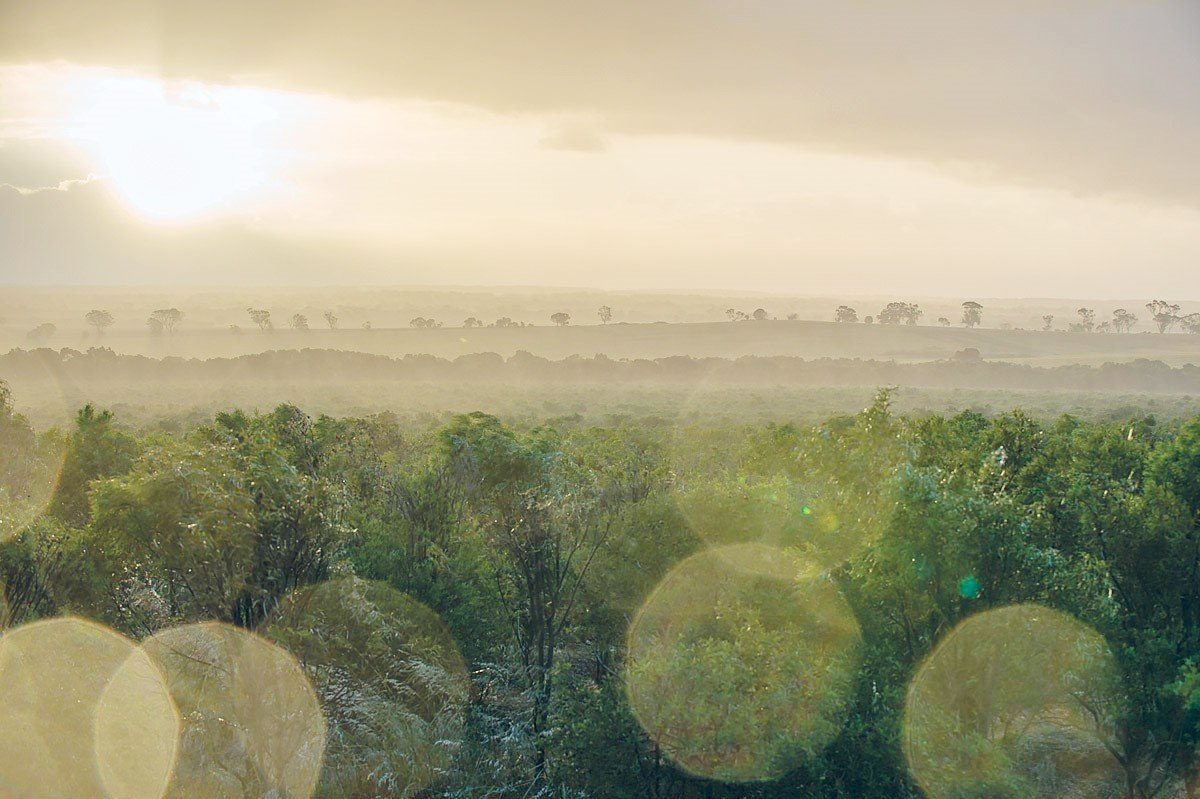More Than a Sacred Tree: The Legacy of Dutjahn
Australian Sandalwood Country
Across the rugged, biodiverse plains of Australia, Traditional Custodians have lived alongside sandalwood (Santalum spicatum) for more than 60,000 years. For these communities, it is more than a sacred tree – it is a link to spirituality, culture and the land.
Australian sandalwood – or ‘Dutjahn’ in Martu or Wongi languages – is a medicine, food, gift and force of protection. Its bark can be ground into a poultice to treat infection and inflammation; its bark, leaves and nuts can be heated and applied to enhance healing and ease muscle pain; its scent is used to ward off snakes and protect communities from evil spirits (Ablard, 2022). At significant moments of contemplation or times of stress, sandalwood is burned by Aboriginal people in the central deserts, its sweet, grounding scent said to calm and align the mind, body and spirit.
Dutjahn Sandalwood Oils was created to honour this legacy. Forged as an equal partnership between Traditional Custodians and the world’s largest cultivators of the Australian sandalwood (Santalum spicatum) species, the company has created a regenerative sourcing model grown upon the ideal that through careful and considered use of nature, biodiversity and people can flourish for generations to come.
It is a process that spans from the Indigenous custodians in the desert lands, planting seeds and reading the land before harvesting; growers in the Wheatbelt tending to the trees and monitoring the native fauna; right through to the in-house perfumers, who sniff each distillation to detect the subtle changes that provenance gifts to each batch, blending the oils to create the final products.
At the heart of each touchpoint, lies the principles of nature – diversity, adaptation, and collaboration – and the Indigenous belief in the interconnectedness of all living things.
Ethical To the Core
As Clinton Farmer casts his gaze across endless expanses of red-dirt scrub where his family roamed for generations before him, his connection to the land – an expanse spanning Australia’s Great Sandy, Little Sandy and Gibson Desert – is so apparent, you can almost see it. “It’s hard country, but when you go there, you will feel the old people looking after you,” he says.
“For us, connection to land is everything. It’s not just about the sandalwood, but about everything that surrounds it – the animals, the trees, the waterways. If you look after the land, the land will look after you.”
One of four Dutjahn Custodians, the Aboriginal-owned entity that is 50% owner of Dutjahn Sandalwood Oils, Clinton is a second-generation sandalwood harvester and Chairman of the Kutkububba Aboriginal Corporation, working on the Birriliburu determination area, part of the Native Title Mungarlu Ngurrarankatja Rirraunkaja (MNR) – a 66,760km2 area larger than the state of California.
Dutjahn Custodians and Directors Clinton Farmer and Darren Farmer holding an Australian Sandalwood log
Working for months in an environment many would consider harsh, Clinton and his harvest team use a combination of traditional ecological knowledge and contemporary science to select and regenerate trees, always guided by a deep-rooted sense of intergenerational responsibility.
Within Western Australia, Aboriginal harvesters working on Native Title lands represent less than 10% of Australian sandalwood harvests each year. When harvesting areas, Traditional Custodians draw on ecological knowledge amassed over millennia, for example preserving between 20 and 40% of trees – far beyond the 10% quota set by the Western Australian Department of Biodiversity, Conservation and Attractions (DBCA).
“That’s always been a part of what my old man taught me – I am harvesting wood that he left behind,” says Clinton. “He could have gone through and harvested all of that but he showed respect. And that’s what has been passed onto me as a custodian so that it’s there for the future.
“That’s showing that respect to the land, by leaving those old trees. And our young ones to keep the species going – I don’t harvest them, I keep them aside.”
This intergenerational responsibility drives his role as Chairman of the K Farmer Dutjahn Foundation (KFDF), an Indigenous-led not-for-profit that receives royalties on the sale of Dutjahn Sandalwood Oils to empower the next generation of sandalwood Custodians to care for their lands and prevent biodiversity loss through culture and landcare projects.
For Clinton, the sacred benefits of sandalwood are a gift he’s proud to share.
“People who are from different cultures, different backgrounds, we are touching them with something special from my land that we've enjoyed for thousands of years,” he says. “It’s giving our people a sense of pride.”
Healing the Land
As an endemic tree, Australian sandalwood (Santalum spicatum) has adapted to the climate and lands, growing in a variety of conditions without the need for irrigation or fertilisers. It thrives with host trees, forming a node known as ‘haustoria’ with nitrogen-fixing trees like Jam trees (Acacia acuminata) to share their water and nutrients (Brand & Pronk, 2011).
“Over time you can see the soil changing because you’re putting vegetable matter back - the (nitrogen-rich) leaves are dropping all year around”
“Sandalwood is a unique tree,” explains Ron Mulder, co-founder of both WA Sandalwood Plantations (WASP) – a commercial cultivator of Australian sandalwood which grows more than 19 million trees in the Wheabelt region of Western Australia - and co-founder of Dutjahn Sandalwood Oils. “It’s a survivor – it can grow in the harshest of conditions. But in order to get the best quality oil, you need to cultivate it in a sustainable way. That means being patient, taking care of the soil, and respecting the ecosystem around it.”
Through his renewable cultivation techniques, Ron has helped farmers regenerate their lands and utilize sandalwood’s natural ability to thrive in poor soils.
“Over time you can see the soil changing because you're actually putting vegetable matter back – the leaves are dropping all year around, and you’ve got other organic matter,” explains Ron. Sandalwood’s nitrogen-rich leaves bolster the soils when they fall, creating biomass that enriches the local microbiome, while the seeds provide a source of food to native fauna. The tree’s fine, lateral root system helps to combat erosion and creates channels that allow water to penetrate (Wheatbelt Natural Resource Management, 2023). It also sequesters carbon from the atmosphere, an effect recognised by Australian Carbon Credit Units issued for the new plantings in 2022.
As part of their efforts to support biodiversity, WASP partnered with the KAC team, and has established a dedicated seed orchard using trees grown from desert seeds. Each year, as many as 350,000 seeds are harvested to support replanting efforts by the KAC team on Mungilli lands – ensuring the regeneration of forests for generations to come.
Cultivated Australian Sandalwood (Santalum spicatum)
Whispering Truths of this Vast, Ancient Land
Branko Lazin opens the door of the Kalgoorlie factory where he works as Distillation Manager, and breathes in the creamy woody scent, a smile spreading across his face. "That's the first part you notice – that beautiful smell of sandalwood,” he says. “It’s a nice place to come and work.” As he walks the factory floor, he surveys the bags of wood chips, carefully labelled and ordered by provenance.
The distillation process is an art form, one that Branko and his colleague Natasha Marques, a qualified environmental engineer and Sales and Operations Manager, administer with expert precision.
“Sandalwood is not just a commodity – it’s a living thing,” says Branko. “Just like humans, it has its own personality, its own character. That’s why we treat each batch with the respect and attention it deserves.”
When growing, Australian sandalwood is small and hardy, its evergreen form echoing the natural environment in which it grows. In the sun-drenched desert, branches can become burnt and mottled, twisting away from the direction of the rays. During drought, growth will stop, making growth rings of a trunk a poor determinant of age. And when cultivated in milder conditions, the tree reaches commercial maturity at around 18 years, producing an aromatic heartwood rich with essential oil.
“Sandalwood is not just a commodity – it’s a living thing. Just like humans, it has its own personality, its own character. That’s why we treat each batch with the respect and attention it deserves.”
Just as its form reflects its place, sandalwood's chemistry and aroma vary according to where the tree has grown and what part of the tree is distilled – the butt, trunk or branches. Understanding these nuances is vital to creating oil with the finest constituents and aroma.
“Provenance plays a huge part in our distillation," says Natasha. "Each provenance will distil in a different way – different timing, yield, and more importantly, chemistry, which brings a different olfactory profile. Because we have a number of suppliers, we have over 12 grades of sandalwood that we can mix and match and blend to create bespoke oils."
“We’re doing a lot of R&D projects and investing our time and effort into improving our efficiencies. So, now that we’ve reached a point that we know how to get the best-smelling oil, we’re working to do this in the most efficient way – with less environmental impact and producing the least waste."
A Regenerative Sourcing Approach
This attention to detail and will to improve extends to every aspect of Dutjahn’s sandalwood production, including the way raw materials are sourced.
According to Guy Vincent, CEO of Dutjahn Sandalwood Oils, also an experienced perfumer and aromatherapist, “We are adopting a new model of business. Rather than the old, extractive approach to natural resources which excluded Aboriginal people, we’re developing a world-leading sourcing model in which Aboriginal people are leading and redefining a more responsible model of sourcing – one that regenerates the lands and redistributes wealth in a fairer way, supporting the self-determination of Indigenous communities.”
This model won Dutjahn Sandalwood Oils the United Nations Equator Prize for nature-based sustainable development, and last year made it the first company to attain Union of Ethical Biotrade (UEBT) Verified Responsibly Sourced Sandalwood Oil.
“Aboriginal people are leading and redefining a more responsible model of sourcing – one that regenerates the lands and redistributes wealth in a fairer way, supporting the self-determination of Indigenous communities.”
“When you evaluate oil quality and supply as an aromatherapist, perfumer or brand, we want you to recognise its cultural significance and the intellectual property rights to a special genetic resource,” he says.
“Australian Sandalwood has been used for centuries in traditional medicine to treat a variety of ailments, including anxiety, depression, and inflammation. For perfumery, it offers an incredible warmth and complexity, with woody, creamy and spicy notes that enhance formulas. But beyond this, there’s also something intangible.”
“When I use Dutjahn sandalwood, I feel like I have a connection to the people who produced it, right through the supply chain. When you know that a raw material is doing good for other people, that feels great."
“This is not just a product – this is a legacy.”
Learn more
Article republished with the permission of Aromatika Magazine
References
Ablard, K (2021) “Sandalwood: Conservation and Custodians”, in In Essence, 20(1).
Battaglia, S. (2022, May 27). Sandalwood. Salvatore Battaglia. Retrieved April 3, 2023, from https://salvatorebattaglia.com.au/essential-oils/167-sandalwood
Brand, J and Pronk, G (2011) “Infuence of age on sandalwood (Santalum spicatum) oil content within different wood grades from five plantations in Western Australia”, Australian Forestry, 74:141–148.
Wheatbelt Natural Resource Management. (n.d.). Sandalwood. Wheatbelt NRM. Retrieved March 3, 2023, from https://www.wheatbeltnrm.org.au/sites/default/files/knowledge_hub/documents/SANDALWOOD-FACT-SHEET-5.pdf







